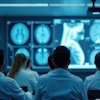Long workdays may reduce the diagnostic accuracy of radiologists because of the increased eyestrain they experience, although the magnitude of the decline does not appear to be major, according to a new study in the September issue of the Journal of the American College of Radiology.
Researchers at the University of Arizona in Tucson and the University of Iowa in Iowa City included 40 attending radiologists and radiology residents in a study that measured radiologists' diagnostic accuracy for fracture detection, as well as their visual accommodation (the ability to maintain focus), reading time, and fatigue and strain before and after a day of clinical reading (JACR, September 2010, Vol. 7:9, pp. 698-704).
"After a day of clinical reading, radiologists have reduced ability to focus on displayed images, increased symptoms of fatigue and oculomotor strain, and reduced detection accuracy," wrote lead author Elizabeth Krupinski, PhD, and colleagues. "Radiologists need to be aware of the effects of fatigue on diagnostic accuracy and take steps to mitigate these effects."
The 40 radiologists viewed 60 bone examinations that had been stripped of any patient identifiers; half the cases had no fractures, and half had a single moderate to very subtle fracture, according to the authors. The cases included wrist, hand, ankle, foot, long bones, shoulder, and rib exams. The average workday for the participating radiologists was eight hours.
The participating radiologists completed surveys covering how many hours of sleep they'd had, whether they had active allergies, the number of hours spent reading that day, and the type of images. They also completed an occupational fatigue inventory that incorporated five factors: lack of energy, physical exertion, physical discomfort, lack of motivation, and sleepiness. Visual strain was measured with a device that collects refractive measurements and pupil diameter measurements every 0.2 seconds; two sets of measurements were taken before and after each reading session.
Detection accuracy dropped for late versus early reading, but the difference was small: The average areas under the curves were 0.885 for early and 0.852 for late readings (p < 0.05).
"It seems that our sample of 40 readers reading 60 multiview examinations was just sufficient to detect this difference at the 0.05 significance level," Krupinksi and colleagues wrote. But "given that a small but significant reduction in detection accuracy was demonstrated for an average workday of about eight hours, we suspect that more extended reading may expose the reader to greater decrements in accuracy."
The team hypothesized that if eyestrain reduced a radiologist's ability to stay focused on an image, he or she might take more time, but that was not the case. On average, each examination took radiologists 50.7 seconds and residents 52.8 seconds to read.
One surprising finding of the study was that fatigue had a bigger impact on residents, Krupinski told AuntMinnie.com.
"For a lot of the measures, the residents were more affected by fatigue than faculty," she said. "I would have thought [that would be reversed], but in general, the residents tend to be more tired by end of the day and their accuracy more decreased. Perhaps the attending radiologists have gotten so good at recognizing when they're tired that they've learned to self-regulate."
Next, Krupinski's team plans to conduct a follow-up study that will explore the relationship between fatigue and reading dynamic images, such as CT.
"If radiologists aren't aware of the fact that they can become fatigued and that that fatigue can reduce accuracy, they could be missing lesions, or making false positives," Krupinski said. "They need to recognize signs of fatigue and learn when to take a break, when to stop."
By Kate Madden Yee
AuntMinnie.com staff writer
September 16, 2010
Related Reading
Staggering rad work shifts improves patient care, September 3, 2010
Study links errors by doctors to long hours, December 13, 2006
After-hours imaging not a cost factor in pediatric appendicitis assessment, February 22, 2006
Reducing interns' work hours decreases serious medical errors, October 28, 2004
Consumer group says mandatory limits on residents' shifts are needed, October 14, 2002
Copyright © 2010 AuntMinnie.com




















